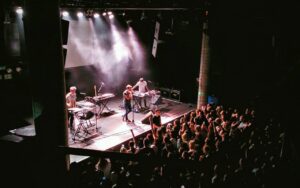Who was the very first “Queen of Noise”? Susie Quattro, of course. This diminutive Detroit-based generator was a success among the then reigning macho makeovers. Plus, no one else (or anyone else) looked as good in a tight leather jumpsuit as she did.
An unusual interview at Susie Quattro’s home.
The first thing Susie Quattro asks me to do is take off… alas, not my shirt or pants or… but my shoes.
We have beige carpets here, you see,” she explains.
I can’t help but notice that she herself is wearing shoes. More specifically, she’s wearing slim, pale blue snakeskin boots that go perfectly with her ripped jeans.
I just had a photo shoot,” Susie Quattro excused herself, lifting her right foot and touching the flawless soles with her finger. It looks like the clearest-eyed 64-year-old woman with the fluffiest hair on this or any other planet. – Look at it, it’s perfectly clean.
It’s a very strange feeling when you’re standing in your socks in the lobby of a large Elizabethan mansion discussing shoe issues with the first “Queen of Noise.” After all, it was Susie Quattro (to use a phrase from her autobiography) who didn’t say she opened the door for female rock musicians, but rather blew it down.
If you were a rock fan in the 1970s, chances are that Quattro’s rise is forever in your memory. The leather-clad, piercing tomboy who exuded a sea of charisma. If she was any kind of collective image, she was certainly not a product of the American commercial industry. Her singles were bold, energetic, noisy and permeated with typical 70’s cues, especially the B-sides.
“Roman Fingers” (“Fondle me, love me till you die” (“Roman Fingers” is a slang term for sexual caresses) and “Glycerine Queen” (“Taking pocket money, giving back dirty secrets”) come immediately to mind, and you wouldn’t want to sprinkle sugar from Shake My Sugar on your breakfast cereal.
Susie Quattro’s house, dating back to the late 16th century and located in Essex near Chelmsford, has been her home for 35 years. It has nine bedrooms and three reception rooms and is surrounded by almost a hectare and a half of land. It even boasts its own moat. (This brings to mind lines from another of her songs, “The Wild One,” “I’m a blue-eyed bitch, and I want to get rich.)
A long, tree-lined gravel road (isn’t there a “devil’s gate” around here?) goes past wooden garages and leads to a circle in front of the house. A huge black Mercedes and a Chrysler Crossfire with German license plates are parked there, indicating that Susie Quattro, her second husband Rainer Haas, who works as a promoter in Hamburg, has now arrived.
We enter the house. Susie walks confidently across the fluffy carpet, her gait reminiscent of a model who walks into a Wild West bar to order a sarsaparilla from the bartender. We walk past the upholstered wood walls adorned with gold discs and stop to peek into her office, which is also the showroom for her 750 pairs of Ray-Ban sunglasses.
I try to wear a different pair every day,” she says, “but I save the vintage ones for special occasions, they’re still pretty valuable.
Finally, we reach the lounge, which is dominated by a portrait of Susie Quattro by Pop Art Brazilian artist Romero Britto. You can see this portrait on the cover of her poetry collection, which came out in December 2014. On the wall beside the fireplace hangs a battered Fender Precision bass guitar, once given to her by her father long ago.
Susie Quatro in 1974 and now (photo)
Quattro sits down on the couch and speaks with her distinctive Michigan accent:
Well, what would you like to know?
Susie Quattro’s first steps in music
Susan Kay Quatro was born in 1950 in Detroit. She was the fourth of five children. From an early age they were all put in their heads:
“You can do it all on your own.”
Her father Art was from Italy and her mother Helen was from Hungary. From an early age, she demonstrated her musical talent and made her stage debut at the age of eight. At that time, she played the bongos in her father’s jazz ensemble.
In 1964, Susie and her sister Patty formed their own band, the Pleasure Seekers, playing garage rock. A third sister, Arlene, soon joined them. As a kind of female version of The Seeds, the sisters proved themselves in the frenetic Detroit scene, led by Alice Cooper, Ted Nugent, Bob Seeger, Mitch Ryder and The Stooges (Susie’s favorite Detroit musician was Bob Hodge of the heavy blues band Catfish).
As the Pleasure Seekers managed to land a contract with the local Hideout label, and then attracted the attention of the major Mercury Records, Susie Quattro left school for the nomadic life of a musician.
At 17, she even ended up in Vietnam, where she entertained American soldiers. In 1969, the Pleasure Seekers smoothly morphed into Cradle (left Arlene, who had to take over parenting, but was replaced by another sister, Nancy). A dramatic change came two years later when Susie met Mickey Most, the English producer and owner of Rak Records, backstage after a Cradle concert at the Grandee Ballroom in Detroit. To see the Cradle band Most was persuaded by Mickey Quattro, the girls’ brother and their promoter, but only a miniature dynamo with a bass guitar sparked Most’s genuine interest.
That night Mickey brought me into the Motown studio with Jeff Beck and Cosy Powell. I will remember that night for the rest of my life. I got the bass, then Jeff and Cosey came in, and we started jamming by winding up Cissy Strut. Dang-di-da-da-dang-dang-dang-dang… dang-di-da-da-dum… You know? I jammed to the tune of this song with Jeff Beck and Cosy Powell! How many people can boast something like that?
Bridge wanted to sign a solo contract with Quattro, but Jack Holtzman, head of Elektra Records, also had his eye on it. You’d think the choice wasn’t that difficult. On the one hand, Elektra was home to The Doors, The Eagles, The MC5 and Love. On the other, Rak had contracts with Mud, Kenny, Arrows and Racey.
Ha ha,” Quattro laughs guttural. – Yeah, I had two offers. It was crazy. Both Jack Holtzman and Mickey wanted to offer me a solo contract. Jack said: “The second Janis Joplin.” But Mickey said: “The first Susie Quattro.” I didn’t want to become the second Janis Joplin. It wasn’t for me at all.
The Susie Most sisters weren’t interested, but he didn’t want to break up the family. Luckily, eventually the Cradle broke up (for natural reasons, not because of Most) and Susie Quattro flew to London.
My father told me, “You see, if you go, your sisters won’t succeed without you.” Oh…the guilt. I felt it for a long period of time. However, it didn’t stop me. It was my path, and I was going to follow it. From a business standpoint, it was easy. But emotionally it was killing me. Still, I had to go.
Away from home: uncertainty and love
Quattro left rumbling Detroit to land noisily in London and find herself in the middle of a burgeoning glitterrock scene. A gentlemen’s club of stale rock historians will tell you that (with the exception of David Bowie and Mark Volan) the charmingly dorky ’70s glam-rock phenomenon was a tasteless pimple on the face of British music.
Not true. It was a golden era, even though on closer inspection that gold looked more like shiny plastic made in Taiwan. It was an era with which the leather-jacketed, stacked on a high platform, husky-voiced Noise Queen Susie Quattro will always be associated. And yet she tries to separate herself from the guys with eyeliner on her eyes.
I’m not sure I’ve ever been a part of the glam scene,” she says. – It’s very ambiguous for me. I may have been part of that era, but I didn’t look like that. I didn’t have any makeup on. The guys wore it. I think I was more of a rock and roll act than a glam act. If you look at me, it’s very noticeable that I’m from Detroit. Simple black skin and edgy demeanor.
It took Susie Quattro a while to get on her feet in England. Mickey Most noticed her budding talent, but when it came to studio work, he didn’t know what to do with her. It took two years for her career to really take off. She went into the studio with guitarist Beat Jim Sullivan, Yes drummer Alan White and keyboardist Free “Bunny” Bandrick.
We were looking,” she admits. – I couldn’t find my niche, finally things more or less fell into place when I said: “I need a band.”
But Bridge was right about one thing. Susie Quattro wasn’t just candy for ’70s teenagers with their curls, oversized collars, 99-pence striped flared pants, and plastic-heeled boots from the Timpsons store.
Mickey told me from the beginning, “You’re a rocker, you have androgynous looks, everyone will like you: straight guys, gay guys, boys, girls.” But here’s what to do with me in the studio, he didn’t know. He never got around to being my producer.
In late 1972, Susie Quattro went on tour to British theater venues with a team of three musicians, including Thin Lizzy and headliners Slade. She managed to win over Slade fans known for their uncompromising attitude and talked to Phil Lynott.
We stayed at Phil’s mother’s hotel when we were in those parts. He was a nice, gentle man, despite his drug problems.
By then, a giant-sized guitarist named Len Taki had joined her band. While touring with Slade, Quattro and Taki became lovers, and he later became her first husband. Did they try to hide their budding relationship from fans so as not to upset them?
I never did. No, no, no,” she answers immediately. – I guess Mickey didn’t want us to get married like that right away, but we started living together from the beginning. It was about two weeks after the tour started. We fell in love, that’s all. We lived together for 20 years.
A life-changing change. Susie Quattro’s songs are blowing everyone away.
The decisive turn in Susie Quattro’s career came in early 1973. It just so happened that as she was walking by, songwriter/producer Mike Chapman happened to be in the reception area of Rak Records.
Mike asked: “Who is this nice girl?” Mickey replied, “That’s my secret weapon, she’s going to be a real star,” she recalls. – “Mickey let Mike listen to the song ‘Rolling Stone,’ which was my first single for Rak. It was pretty quiet. Mike said: “It’s amazing, and I thought, looking at her appearance, that she was performing something really bold and daring.” For Mickey, it was a revelation.
Chapman and co-writer Nicky Chinn wrote the song Can The Can for Quattro. Wild, fierce and endlessly commercial, it reached number one in Britain in June 1973.
The musicians of The Quadro Band appeared on Top Of The Pops, and the whole country looked on in amazement. This was no token Dana, with All Kinds Of Everything, or Linea De Paul with her neat haircut and tons of lipstick.
No, this was a snarling demon from Daytona, head-to-toe clad in leather, tossing sand in your face and then happily rubbing it into your forehead.
Incidentally, it is widely known that in her Record Mirror interview, De Paul called Susie Quattro a “lesbian.” She later said she was misquoted and she used the word “masculine.” How it really was, no one knows for sure, since the tape turned out to have been mysteriously deleted.


